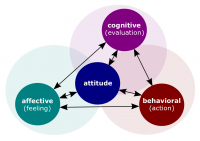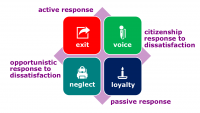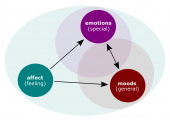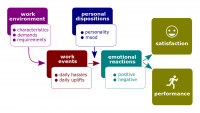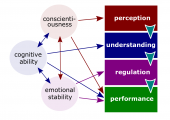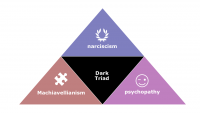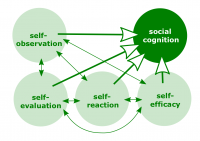Difference between revisions of "OB personality concepts"
| Line 1: | Line 1: | ||
| − | [[OB personality concepts]] are those [[concept]]s that are related to | + | [[OB personality concepts]] are those [[concept]]s that are related to [[attitude]]s, [[job satisfaction]], [[affect]], [[personality]], and [[core value]]s researched in the [[organizational behavior]] science. The concepts below are taken from [[Organizational Behavior by Robbins and Judge (17th edition)]]; [[Septem Artes Administrativi]] served as the primary source of illustrations. |
| + | |||
==Attitudes== | ==Attitudes== | ||
Revision as of 02:03, 2 December 2018
OB personality concepts are those concepts that are related to attitudes, job satisfaction, affect, personality, and core values researched in the organizational behavior science. The concepts below are taken from Organizational Behavior by Robbins and Judge (17th edition); Septem Artes Administrativi served as the primary source of illustrations.
Attitudes
- Attitude. An evaluative statement or judgment concerning objects, people, or events.
- Cognitive component. The opinion or belief segment of an attitude.
- Affective component. The emotional or feeling segment of an attitude.
- Behavioral component. The behavioral segment of an attitude that constitutes an intention to behave in a certain way toward someone or something.
- Cognitive dissonance. Any incompatibility between two or more attitudes or between behavior and attitudes.
Job satisfaction
- Job satisfaction. A positive feeling about one's job resulting from an evaluation of its characteristics.
- Job involvement. The degree to which a person identifies with a job, actively participates in it, and considers performance important to self-worth.
- Psychological empowerment. Employee's belief in the degree to which they affect their work environment, their competence, the meaningfulness of their job, and their perceived autonomy in their work.
- Organizational commitment. The degree to which an employee identifies with a particular organization and its goals and wishes to maintain membership in the organization.
- Perceived organizational support. The degree to which employees believe an organization values their contribution and cares about their well-being.
- Employee engagement. An individual's involvement with, satisfaction with, and enthusiasm for the work he or she does.
- Corporate social responsibility. An organization's self-regulated actions to benefit society or the environment beyond what is required by law.
- Exit. Dissatisfaction expressed through behavior directed toward leaving the organization.
- Voice. Dissatisfaction expressed through active and constructive attempts to improve conditions.
- Loyalty. Dissatisfaction expressed by passively waiting for conditions to improve.
- Neglect. Dissatisfaction expressed through allowing conditions to worsen.
- Counterproductive work behavior. Actions that actively damage the organization, including stealing, behaving aggressively toward coworkers, or being late or absent.
Emotions and moods
- Affect. A broad range of feelings that people experience.
- Emotion. Intense feelings that are directed at someone or something.
- Mood. Feelings that tend to be less intense than emotions and that lack a contextual stimulus.
- Moral emotion. An emotion that have moral implications.
- Positive affect. A mood dimension that consists of specific positive emotions such as excitement, enthusiasm, and elation at the high end.
- Negative affect. A mood dimension that consists of specific negative emotions such as nervousness, stress, and anxiety at the high end.
- Positivity offset. The tendency of most individuals to experience a mildly positive mood at zero input (when nothing in particular is going on).
- Affect intensity. Individual differences in the strength with which individuals experience their emotions.
- Illusory correlation. The tendency of people to associate two events when in reality there is no connection.
- Emotional labor. A situation in which an employee expresses organizationally desired emotions during interpersonal transactions at work.
- Felt emotion. An individual's actual emotions.
- Displayed emotion. An emotion that is organizationally required and considered appropriate in a given job.
- Surface acting. Hiding one's inner feelings and forgoing emotional expressions in response to display rules.
- Deep acting. Trying to modify one's true inner feelings based on display rules.
- Emotional dissonance. Inconsistencies between the emotions people feel and the emotions they project.
- Mindfulness. Objectively and deliberately evaluating the emotional situation in the moment.
- Affective events theory. A model that suggests that workplace events cause emotional reactions on the part of employees, which then influence workplace attitudes and behaviors.
- Emotional intelligence. The ability to detect and to manage emotional cues and information.
Personality
- Personality. The sum total of ways in which an individual reacts to interacts with others.
- Heredity. Factors determined at conception; one's biological, physiological, and inherent psychological makeup.
- Personality trait. An enduring characteristic that describes an individual's behavior.
- Myers-Briggs Type Indicator. A personality test that taps four characteristics and classifies people into one of 16 personality types.
- Big Five Model. A personality assessment model that taps five basic dimensions.
- Conscientiousness. A personality dimension that describes someone who is responsible, dependable, persistent, and organized.
- Emotional stability. A personality dimension that characterizes someone as calm, self-confident, and secure (positive) versus nervous, depressed, and insecure (negative).
- Extraversion. A personality dimension describing someone who is sociable, gregarious, and assertive.
- Openness to experience. A personality dimension that characterizes someone in terms of imagination, sensitivity, and curiosity.
- Agreeableness. A personality dimension that describes someone who is good natured, cooperative, and trusting.
- Dark Triad. A constellation of negative personality traits consisting of Machiavellianism, narcissism, and psychopathy.
- Machiavellianism. The degree to which an individual is pragmatic, maintains emotional distance, and believes that ends can justify means.
- Narcissism. The tendency to be arrogant, have a grandiose sense of self-importance, require excessive admiration, and have a sense of entitlement.
- Psychopathy. The tendency for a lack of concern for others and lack of guilt or remorse when actions cause harm.
- Core self-evaluation. Bottom-line conclusions individuals have about their capacities, competence, and worth as a person. In other words, self-believing in one's inner worth and basic competence.
- Self-monitoring. A personality trait that measures an individual's ability to adjust his or her behavior to external, situational factors.
- Proactive personality. People who identify opportunities, show initiative, take action, and persevere until meaningful change occurs.
- Situation strength theory. A theory indicating that the way personality translates into behavior depends on the strength of the situation.
- Trait activation theory. A theory that predicts that some situations, events, or interventions "activate" a trait more than others.
Values
- Core value (collectively, also known as values). A basic conviction that a specific mode of conduct or end-state of existence is personally or socially preferable to an opposite or converse mode of conduct or end-state of existence.
- Values system. A hierarchy based on a ranking of an individual's values in terms of their intensity.
- Terminal value. A desirable end-state of existence; the goal a person would like to achieve during his or her lifetime.
- Instrumental value. A preferable mode of behavior or mean of achieving one's terminal values.
- Personality-job fit theory. A theory that identifies six personality types and proposes that the fit between personality type and occupational environment determines satisfaction and turnover.
- Person-organization fit. A theory that people are attracted to and selected by organizations that match their values, and leave when there is not compatibility.
- Power distance. A national culture attribute that describes the extent to which a society accepts that power in institutions and organizations is distributed unequally.
- Individualism. A national culture attribute that describes the degree to which people prefer to act as individuals rather than as members of groups.
- Collectivism. A national culture attribute that describes a tight social framework in which people expect others in groups of which they are a part to look after them and protect them.
- Masculinity. A national culture attribute that describes the extent to which the culture favors traditional masculine work roles of achievement, power, and control. Societal values are characterized by assertiveness and materialism.
- Femininity. A national culture attribute that indicates little differentiation between male and female roles; a high rating indicates that women are treated as the equals of men in all aspects of the society.
- Uncertainty avoidance. A national culture attribute that describes the extent to which a society feels threatened by uncertain and ambiguous situations and tries to avoid them.
- Long-term orientation. A national culture attribute that emphasizes the future, thrift, and persistence.
- Short-term orientation. A national culture attribute that emphasizes the present and accepts change.
